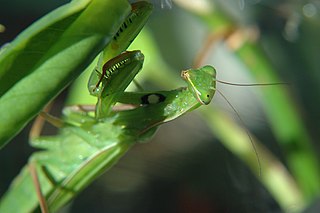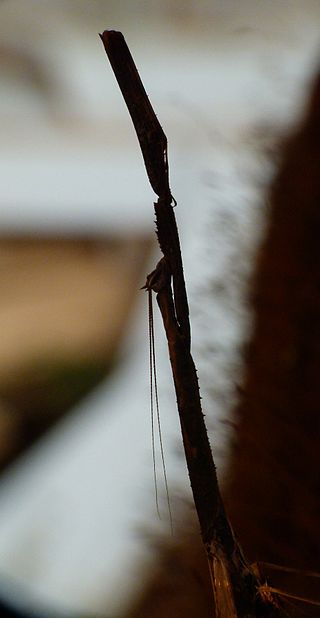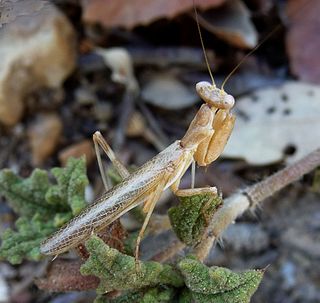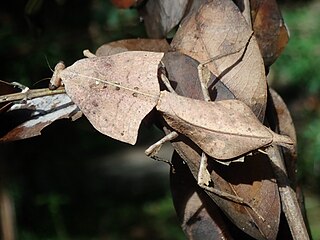
Mantis shrimp are carnivorous marine crustaceans of the order Stomatopoda. Stomatopods branched off from other members of the class Malacostraca around 400 million years ago. Mantis shrimp typically grow to around 10 cm (3.9 in) in length, while a few can reach up to 38 cm (15 in). A mantis shrimp's carapace covers only the rear part of the head and the first four segments of the thorax. Varieties range in colour from shades of brown to vivid colours, with more than 520 species of mantis shrimp known. They are among the most important predators in many shallow, tropical and subtropical marine habitats. However, despite being common, they are poorly understood, as many species spend most of their lives sheltering in burrows and holes.

The Chinese mantis is a species of mantis native to Asia and the nearby islands. In 1896, this species was accidentally introduced by a nursery tender at Mt. Airy near Philadelphia, United States. Tenodera sinensis often is erroneously referred to as Tenodera aridifolia sinensis because it was at first described as a subspecies of Tenodera aridifolia, but Tenodera sinensis is now established as a full species.

Mantidae is one of the largest families in the order of praying mantises, based on the type species Mantis religiosa; however, most genera are tropical or subtropical. Historically, this was the only family in the order, and many references still use the term "mantid" to refer to any mantis. Technically, however, "mantid" refers only to members of the family Mantidae, and not the numerous remaining families of mantises. Some of the most recent classifications have promoted a number of the mantid subfamilies to the rank of family, e.g. Iridopterygidae, Sibyllidae, Tarachodidae, Thespidae, and Toxoderidae, while other classifications have reduced the number of subfamilies without elevating them to higher rank.

Metallyticus is a genus of praying mantis. It is the only genus in the monotypic family Metallyticidae. They are mostly found in South-East Asia. The species of the genus are dark, somewhat flattened and cockroach-like, and often with a cuticle that is reflective and metallic in appearance.

Mantoida is a genus of praying mantises in the family Mantoididae. The species of this genus are native to Mexico, Central America, and South America.

Hymenopodidae is a family of the order Mantodea (mantises), which contains six subfamilies. Some of the species in this family mimic flowers and are found camouflaged among them; these are called flower mantises. Their coloration is aggressive mimicry, luring prey to approach close enough to be seized and eaten.

Sibylla pretiosa, commonly known as the cryptic mantis, is a species of mantis found in southern Africa. They have a long and thin prothorax. The distinctively ornamented species has projections on the head, prothorax, and four femora. They live on tree bark in woodlands.

Squilla mantis is a species of mantis shrimp found in shallow coastal areas of the Mediterranean Sea and the Eastern Atlantic Ocean: it is also known as "pacchero" or "canocchia". Its abundance has led to it being the only commercially fished mantis shrimp in the Mediterranean.

The genus Mantis is in the family Mantidae, of the mantis order Mantodea.

Idolomantis is a monotypic genus of praying mantises in the family Empusidae. It contains the single species, Idolomantis diabolica, commonly known as the devil's flower mantis or giant devil's flower mantis. It is one of the largest species of praying mantises, and is possibly the largest that mimics flowers.

Orthodera novaezealandiae, known as the New Zealand mantis or New Zealand praying mantis, is a species of praying mantis which is, as both the scientific name and common names suggest, indigenous and endemic to New Zealand.

Rhombodera is a genus of praying mantises native to Asia and possessing common names such as shield mantis, hood mantis, and leaf mantis because of their extended, leaf-like thoraxes.

Oratosquilla oratoria, the Japanese mantis shrimp, is a species of mantis shrimp found in the western Pacific. It is widely harvested in Japan and eaten as sushi. Like other members of its order it has a powerful spear, which it uses to hunt invertebrates and small fish. It grows to a length of 185 millimetres (7.3 in), and lives at depths of 10–100 metres (33–328 ft).

Tarachodidae is a now obsolete family in the order Mantodea, of genera found in Africa and Asia.

Toxoderidae is a family of praying mantises.

The bark mantises and ground mantises are praying mantises now placed in the family Eremiaphilidae that are native to the Afrotropics. They are generally light brown but more silvery on the wings. The wings are attractively reticulated, and the veins may be mottled dark and pale. The head is wider than the pronotum, which is rounded anteriorly, and doesn't overlap with the rear of the head. The pronotum is depressed, with its sides more or less parallel, and only a weak supra-coxal bulge is present. The anterior tibia are flattened and greatly expanded longitudinally, and the tibial claw does not fit into a pit between the 1st and 2nd external spines of the anterior femora, as in a few mantis groups.

Mantises are an order (Mantodea) of insects that contains over 2,400 species in about 460 genera in 33 families. The largest family is the Mantidae ("mantids"). Mantises are distributed worldwide in temperate and tropical habitats. They have triangular heads with bulging eyes supported on flexible necks. Their elongated bodies may or may not have wings, but all Mantodea have forelegs that are greatly enlarged and adapted for catching and gripping prey; their upright posture, while remaining stationary with forearms folded, has led to the common name praying mantis.

The mantis family Amelidae was previously placed in the family Mantidae. Species have been recorded from Africa, Asia, Europe and North America.

The Deroplatyidae are a new (2019) family of praying mantises, based on the type genus Deroplatys. As part of a major revision of mantis taxonomy, the subfamily Deroplatyinae has been moved here from the previously structured family Mantidae.




















